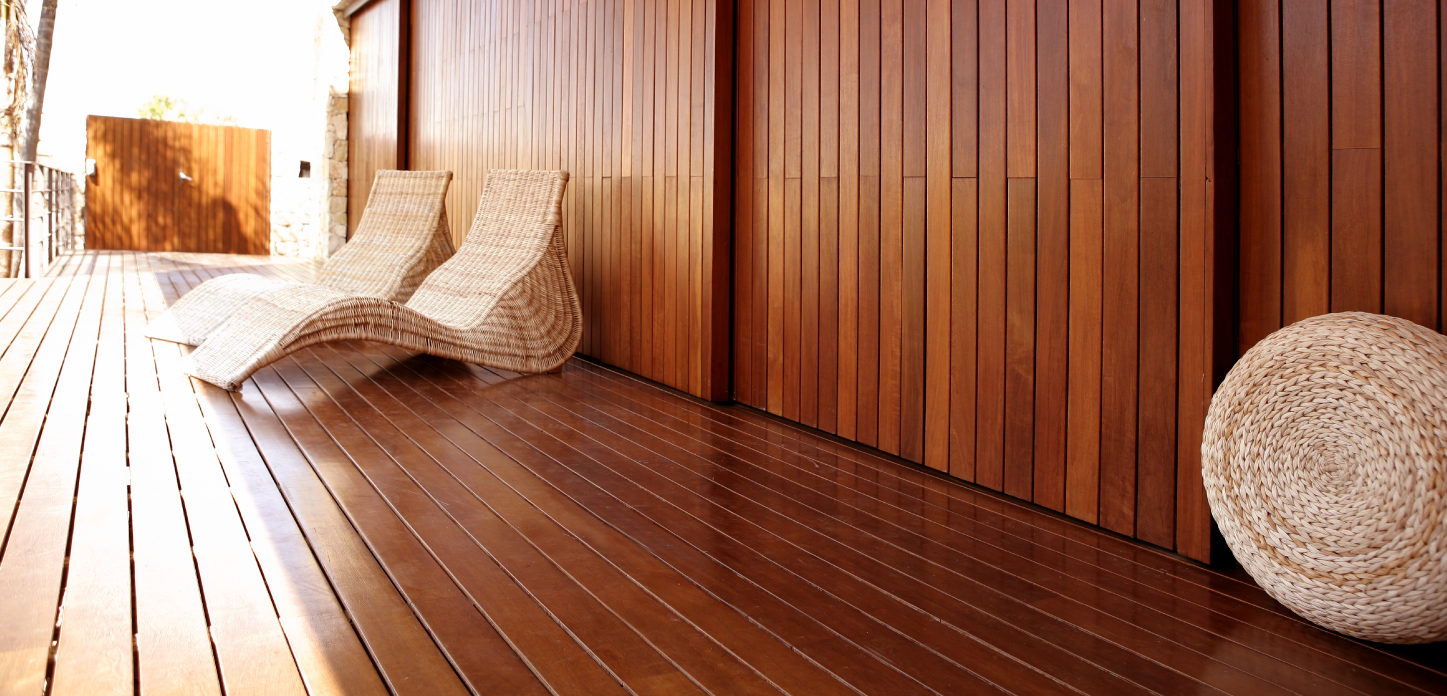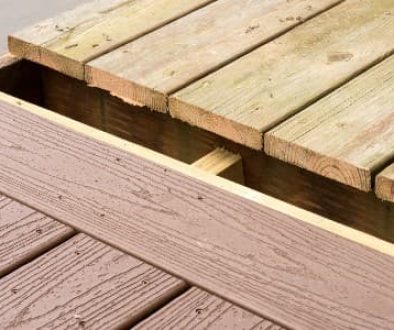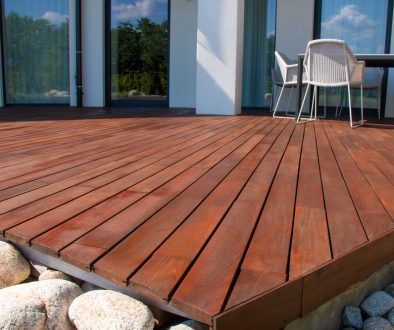Ipe vs Cumaru: Comparing the Top Species of Hardwood Decking

Ipe vs Cumaru: Comparing the Top Species of Hardwood Decking
Ipe VS Cumaru: For those not in the decking, construction, or design industries, these words may not ring a bell. But take a stroll through any big city, like New York City or Los Angeles, and you’ll likely spot them seamlessly blending into homes and businesses.
Decks, walls, ceilings – you name it, ipe and cumaru are there, bringing a touch of South American durability and richness to American cities, suburbs, and even rural residences. Today, we’re diving into what makes tropical hardwoods like ipe and cumaru a top choice for architects, designers, and homeowners across the globe. We’ll also dive into the differences between them so you’ll hopefully have a favorite by the end of the article.
(Hint: Both are great and serve different purposes. We won’t reveal ours so you can make your own decision…).
Before we look at the key differences between Ipe VS Cumaru in terms of decking and other applications, let’s start with their origins, key characteristics, and fun facts.
Best Hardwood Supply in Los Angeles
Request a FREE Quote!
What Is Ipe Wood?

Ipe (pronounced ee-pay), also known as Brazilian Walnut or Lapacho, is one of the densest hardwoods on the planet and grows in South and Central America in countries such as Brazil, Argentina, and Paraguay. It grows to be 140-150 feet tall, according to NovaUSAWood!
With a janka hardness rating of 3,680, ipe sinks in water, which goes to show how dense it really is. Interestingly, ipe has been used as railroad ties because it is *that* resistant to fungus and decay. Other than fungus and decay, ipe is also resistant to extreme weather conditions, splintering, scratching, rotting, and termites.

Ipe has long been regarded as the strongest wood for outdoor decking projects because of its durability, functionality, and aesthetic appeal. With a lifetime of nearly 75 years if installed properly, ipe has been used in tons and tons of residential and commercial projects internationally. Many major public spaces use ipe because of its long-lasting and low-maintenance benefits, such as the Coney Island Boardwalks, as seen in the NY Times.
What Is Cumaru Wood?

Cumaru (pronounced koo-muh-roo), also known as Brazilian Chestnut or Brazilian Teak, is known for its rich reddish brown color and has its origins in South and Central America. It has a janka hardness of 3,340, making it an excellent decking choice and great alternative to ipe.
Like ipe, cumaru grows to tall heights with an average cumaru tree at 130-160 feet tall. Cumaru is also weather, splinter, scratch, termite, and rot-resistant like ipe. Although there are many other tropical hardwoods out there, cumaru was one of the first exotic hardwoods to be used as an alternative to ipe for decking and siding projects worldwide!

While ipe is more well-known and used in commercial and residential projects, cumaru has some benefits that homeowners, contractors, and designers appreciate more.
Ipe vs Cumaru: Differences in Decking & Design
Color:
While both ipe and cumaru boast a broad spectrum of exotic colors and distinctive graining, each has its own unique hues. Cumaru leans towards yellow-brown or reddish-brown hues, earning it the names “Brazilian Teak” and “Brazilian Walnut.” In contrast, ipe spans a range from tan to olive-brown, occasionally dipping into near-black shades, earning it the nickname “Brazilian Walnut.”
Grain:
Beyond their colorful personalities, the grains of these hardwoods distinct one from the other as well. Ipe showcases a finer grain appearance, adding a touch of elegance to its strength. On the other hand, cumaru boasts coarse graining, giving it a unique and robust aesthetic.
Price Point:
When it comes to the bottom line, pricing plays a crucial role. Cumaru, the cost-conscious contender, typically offers a 20% to 30% savings compared to ipe. The budget-savvy homeowner or contractors on a strict project budget can find a reliable ally in cumaru without compromising on quality.
With that being said, life cycle cost analyses show that both ipe and cumaru are the lowest overall cost decking material options over the project lifetime because of their high densities that allow them to last decades more than traditional woods like cedar, cypress, redwood, douglas fir, and pine.
Shrinkage:
Cumaru, with its remarkable qualities, does come with a caveat. It can exhibit certain instabilities leading to shrinkage, according to Hardwood Floors Magazine. To mitigate this, a pre-decking kiln-drying application is advised. At Brazilian Lumber, all of our tropical hardwoods are kiln-dried (KD), which is much higher quality than air-dried (AD) tropical woods because they last longer and are, therefore, stronger investments.
Best Hardwood Supply in Los Angeles
Request a FREE Quote!
Strength and Durability:
Ipe and cumaru are renowned for their strength, making either a formidable choice for decking. If you live near the ocean or other bodies of water, ipe’s resistance to cupping makes it a preferred option. Docks on both coasts —from California to Florida— prioritize using ipe for this reason, as well as because ipe has a natural slip resistance. Ipe’s longevity, with a lifespan of up to 75 years, (more than four times the endurance of most pressure-treated woods), puts it above most woods, including cumaru.
Maintenance:
On the other hand, for those seeking minimal maintenance, cumaru emerges as the winner. Ipe, while long-lasting, demands proper care to maintain its dark brown hue, turning to a grayish brown when exposed to sun.
But this can be resolved with UV-protectant oils, like Penofin and Ipe Oil, that we stock at Brazilian Lumber. Moreover, sealing ipe ends after cutting is essential to prevent moisture-induced shifts. Cumaru, with its lower maintenance requirements, is a practical choice for those with a busy schedule.
Environment and Responsibility:
Environmental considerations also shape the choice between these two hardwoods. Both have experienced overharvesting at times, which is why it is important to check that the wood you buy is certified by the Forest Stewardship Council, that ensures a strict chain of command and that only non-viable trees are harvested. With the environmental practices FSC maintains of its members, tropical hardwoods like ipe and cumaru can continue to flourish in the forests while also allowing individuals worldwide to benefit from their functionality and beauty.
Ipe Vs Cumaru: The Best Fit for Your Deck
In the end, the choice between Ipe VS Cumaru hinges on your specific needs. If you prioritize a fine-grained, elegant appearance with a higher budget and a more resistant wood, ipe might be your go-to. On the other hand, if you seek robustness, a coarser grain, and cost savings, cumaru could be your winner.
Both cumaru and ipe have their own merits, and either can bring beauty and functionality to your outdoor space. The decision ultimately rests on your preferences, budget, and commitment to maintenance. Whichever you choose, your deck will be a testament to the enduring beauty of tropical hardwoods.
For further guidance and expertise in wood selection, don’t hesitate to reach out to us at Brazilian Lumber. Download our brochure to get a better understanding of the products we sell and how they can play a role in your next project. With years of experience in the decking and lumber industry, we can do our best to advise you on what direction to take for your upcoming projects.
Best Hardwood Supply in Los Angeles
Request a FREE Quote!




